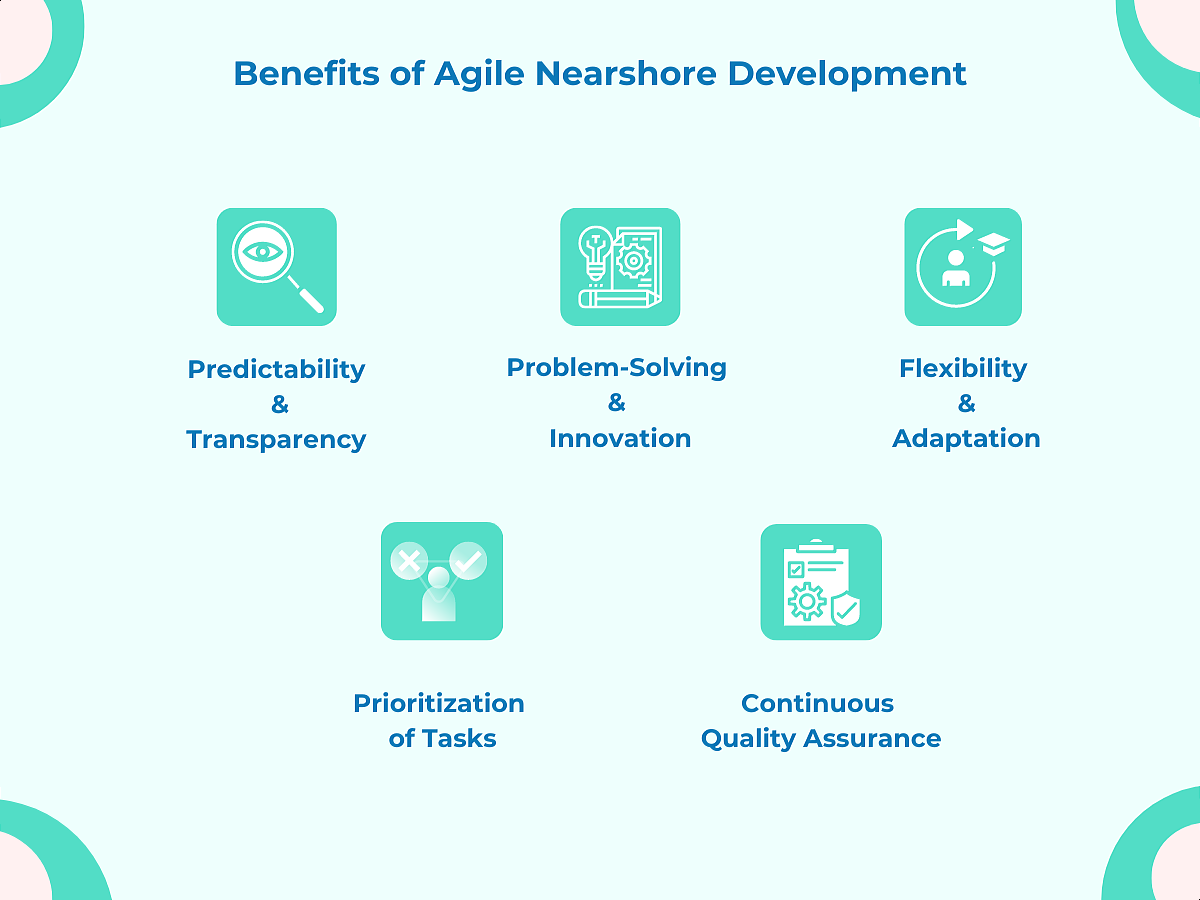The term Agile nearshore development blends Agile principles—iterative progress, collaboration, and flexibility—with the strategic benefits of nearshore outsourcing, such as accessing larger skilled talent pools and optimizing costs.
Given the remote collaboration in nearshoring, adopting Agile methodologies is logical to achieve better workflows and communication.
However, implementing them is nuanced and should be adapted to fit the unique dynamics of working with nearshore teams.
Before dipping into these nuances, let us first look at the origins of the concepts and their intersection in practice.
What is Agile Software Development?
Agile methodology appeared in the late 1990s as a response to the limitations of traditional project management models like Waterfall. The Agile Manifesto, published in 2001, introduced a set of values including:
- Individuals and interactions over processes and tools
- Working software over comprehensive documentation
- Customer collaboration over contract negotiation
- Responding to change over following a plan
In addition, the manifesto also outlines 12 principles that guide agile practices. They emphasize customer satisfaction, welcoming change, frequent delivery of working software, close collaboration, and continuous improvement.
Summarized Principles of the Agile Manifesto
1. The highest priority is to satisfy the customer through early and continuous delivery of valuable software.
2. Welcome changing requirements, even late in development, to harness the customer’s competitive advantage.
3. Deliver working software frequently, from a couple of weeks to a couple of months, with a preference for the shorter timescale.
4. Business people and developers must work together daily throughout the project.
5. Build projects around motivated individuals, provide the environment and support they need, and trust them to get the job done.
6. The most efficient and effective method of conveying information to and within a development team is face-to-face conversation.
7. Working software is the primary measure of progress.
8. Agile processes promote sustainable development. The sponsors, developers, and users should be able to maintain a constant pace indefinitely.
9. Continuous attention to technical excellence and good design enhances agility.
10. Simplicity—the art of maximizing the amount of work not done—is essential.
11. The best architectures, requirements, and designs emerge from self-organizing teams.
12. At regular intervals, the team reflects on how to become more effective, then tunes and adjusts its behavior accordingly.
Today, Agile in software development leverages popular frameworks like Scrum and Kanban or less prevalent options like Extreme Programming (XP) and other alternatives.
Teams work in short cycles or iterations, focusing on delivering functional software incrementally. Additionally, regular practices, such as planning sessions, daily meetings, and retrospectives, are used for continuous communication and improvement, allowing teams to adapt to changing requirements and feedback.
The Intersection of Agile and Nearshore Software Development
Nearshore software development is outsourcing software projects or tasks to professionals in nearby countries via a service provider working in the same or similar time zones. It is a remote-first setup and arguably the most sought-after outsourcing model due to cost-effectiveness and a better cultural match between the collaborating teams, which can be an issue in offshoring.
Did we pique your interest? Learn more about the model’s value in the Key Aspects of Modern Nearshore Software Development.
For distributed teams to function, establishing processes between the client and the nearshore company is necessary. The modern practices of Agile align well with nearshore outsourcing. Specifically, iterative cycles, regular daily meetings, and feedback sessions can bring steady progress, rapid response to changing requirements, and fewer misunderstandings.
We can notice a synergy here. However, there are caveats to consider that also stand for software development in general.
Agile nearshore development also requires careful management to avoid rigid adherence without considering the project context or adapting accordingly, which can strain the software development professionals.
To that point, we will outline the benefits and challenges of this strategy next and observe where the balance lies.
The Benefits of Agile Nearshore Software Development
Combining Agile with nearshore development leads to several advantages:
- Predictability and Transparency: Regular updates through daily meetings, like stand-ups and iteration reviews, keep everyone aligned and aware of progress and issues, helping nearshore teams stay on schedule and make timely adjustments. Daily stand-ups with Scrum and the Kanban visual workflow tools are usual examples of how transparency is maintained.
- Flexibility and Adaptation: The iterative nature of Agile allows swift adjustments to changing requirements, a critical aspect in dynamic environments such as nearshore setups. Specifically, if market conditions or client needs change, the nearshore development team can pivot and adapt their priorities without too many disruptions. For instance, the Kanban continuous flow model allows for real-time prioritization and adaptation, while structured sprints in Scrum provide intervals for reassessment.
- Prioritization of Tasks: Agile frameworks can help outline high-priority tasks that deliver the most value. With regular reassessing and grooming of the backlog, teams allocate resources better and focus on the most beneficial features to the client and, hence, the customer.
- Continuous Quality Assurance: Agile emphasizes regular testing and feedback loops to maintain high-quality development. Frequent reviews and iterations help teams identify and address issues early, reducing the risk of significant problems later on. Sprint reviews offer opportunities to demonstrate progress to stakeholders and gather actionable feedback, leading to steady improvement.
- Problem-Solving and Innovation: Agile encourages a proactive approach to identifying and solving problems early. Regular retrospectives, common in Scrum and other Agile methodologies, enable teams to reflect on their processes and outcomes. In nearshore collaborations, this feedback loop bridges potential gaps in communication and understanding, creating a more coordinated working environment.

The Challenges of Agile Nearshoring
Despite the advantages, nearshore agile development comes with a set of challenges, which include:
- Over-Reliance on Agile Methodologies: Strict commitment to specific aspects can sometimes be counterproductive. For example, an excessive focus on story points might shift attention from delivering actual value to meeting arbitrary metrics. So, advisably, these techniques should be used as flexible guidelines rather than rigid rules.
- Communication Overload: Frequent meetings required by modern Agile practices can become overwhelming. If not managed, the overload can lead to burnout and reduced productivity. For instance, daily meetings should focus on quick updates so follow-ups move to sessions involving only the relevant team members.
- Understanding Project Context: In the initial phases, nearshore teams might struggle to understand the broader project context if proper onboarding is lacking. Potentially, the issue is highlighted even more in Agile environments where rapid iterations are the norm. So, establishing clear objectives and shared knowledge of the project goals from the start is necessary to bridge this gap.
In our experience as a nearshore software company, addressing these challenges is vital for building successful nearshore development teams.
A Practical Approach to Agile Nearshore Development
Implementing Agile in a nearshore outsourcing context can deliver notable benefits but requires careful management and adaptation. Key considerations include:
- Agile is probably best viewed as a mindset for iterative progress, collaboration, and flexibility.
- Applying frameworks like Scrum, Kanban, Lean, or XP has merits, but Agile’s core principles should guide their application.
- Clear objectives and a shared vision will prevent Agile from becoming a catch-all solution in a nearshore setup.
- Assigning a product owner who understands Agile practices and nearshore development nuances will promote more coherent communication and coordination.
Ultimately, these strategies are most effective when integrated with a reliable nearshore software development partner with proven experience and openness to adaptability. They can guide and tailor Agile practices to fit your cross-team collaboration and software development needs, providing a cohesive and productive partnership.
We are here to help you with that. If you have any questions or would like to discuss the benefits of a custom approach to Agile in nearshore development further, you can book a free consultation by dropping us a message below. As always, we will do our best to steer you in the right direction!



